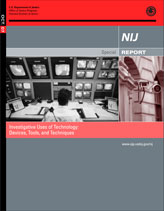Investigative Uses of Technology: Devices, Tools, and Techniques
U.S. Department of Justice
Office of Justice Programs
Introduction
 This special report is intended to be a resource to any law enforcement personnel (investigators, first responders, detectives, prosecutors, etc.) who may have limited or no experience with technology-related crimes or with the tools and techniques available to investigate those crimes. It is not all inclusive. Rather, it deals with the most common techniques, devices, and tools encountered.
This special report is intended to be a resource to any law enforcement personnel (investigators, first responders, detectives, prosecutors, etc.) who may have limited or no experience with technology-related crimes or with the tools and techniques available to investigate those crimes. It is not all inclusive. Rather, it deals with the most common techniques, devices, and tools encountered.
Technology is advancing at such a rapid rate that the information in this special report must be examined in the context of current technology and practices adjusted as appropriate. It is recognized that all investigations are unique and the judgment of investigators should be given deference in the implementation of this special report. Circumstances of individual cases and Federal, State, and local laws/rules may require actions other than those described in this special report.
When dealing with technology, these general forensic and procedural principles should be applied:
- Actions taken to secure and collect evidence should not change that evidence.
- Activity relating to the seizure, examination, storage, or transfer of electronic evidence should be fully documented, preserved, and available for review.
- Specialized training may be required for the examination of many of the devices described in this special report. Appropriate personnel should be consulted prior to conducting any examination. For more information on the seizure or examination of electronic evidence, see the other special reports in this series:
Contents
- Technology Working Group for Investigative Uses of High Technology
- Introduction
- Chapter 1. Techniques
- Introduction
- Investigative assistance
- Information gathering
- Digital evidence
- Electronic communications
- Telecommunications
- Video surveillance
- Consensual monitoring
- Tracking
- Practical example
- Chapter 2. Tools and Devices
- Introduction
- Power concerns with battery-operated devices
- Access-control devices
- Answering machines and voice mail systems (digital and analog)
- Audio: Digital tools used to conduct examinations of audio formats
- Caller ID devices
- Cell phones
- Computers (desktops and laptops)
- Credit card fraud devices
- Customer or user cards and devices
- Data preservation (duplicating, imaging, copying)
- Detection and interception (wireless)
- Digital cameras and Web cameras
- Digital security cameras
- Encryption tools and passphrase protection
- Facsimile (fax)
- Global positioning system devices
- Home entertainment
- Internet tools
- Internet tools to identify users and Internet connections (investigative)
- Keystroke monitoring
- Mass media copiers and duplicators
- Pagers
- Pens and traps
- Personal digital assistants
- Removable storage media and players
- Sniffers
- Steganography
- Vehicle black boxes and navigation systems
- Video and digital image analysis tools
- Voice recorder (digital)
- Chapter 3. Legal Issues for the Use of High Technology
- Introduction
- Constitutional issues
- Searches and seizures pursuant to warrants
- Warrantless searches
- Statutes that affect the seizure and search of electronic evidence
- Appendix A. Glossary
- Appendix B. Technical Resources List
- Appendix C. Hacked Devices
- Appendix D. Disclosure Rules of ECPA
- Appendix E. Sample Forms
- Appendix F. References
- Appendix G. List of Reviewing Organizations
- Index

